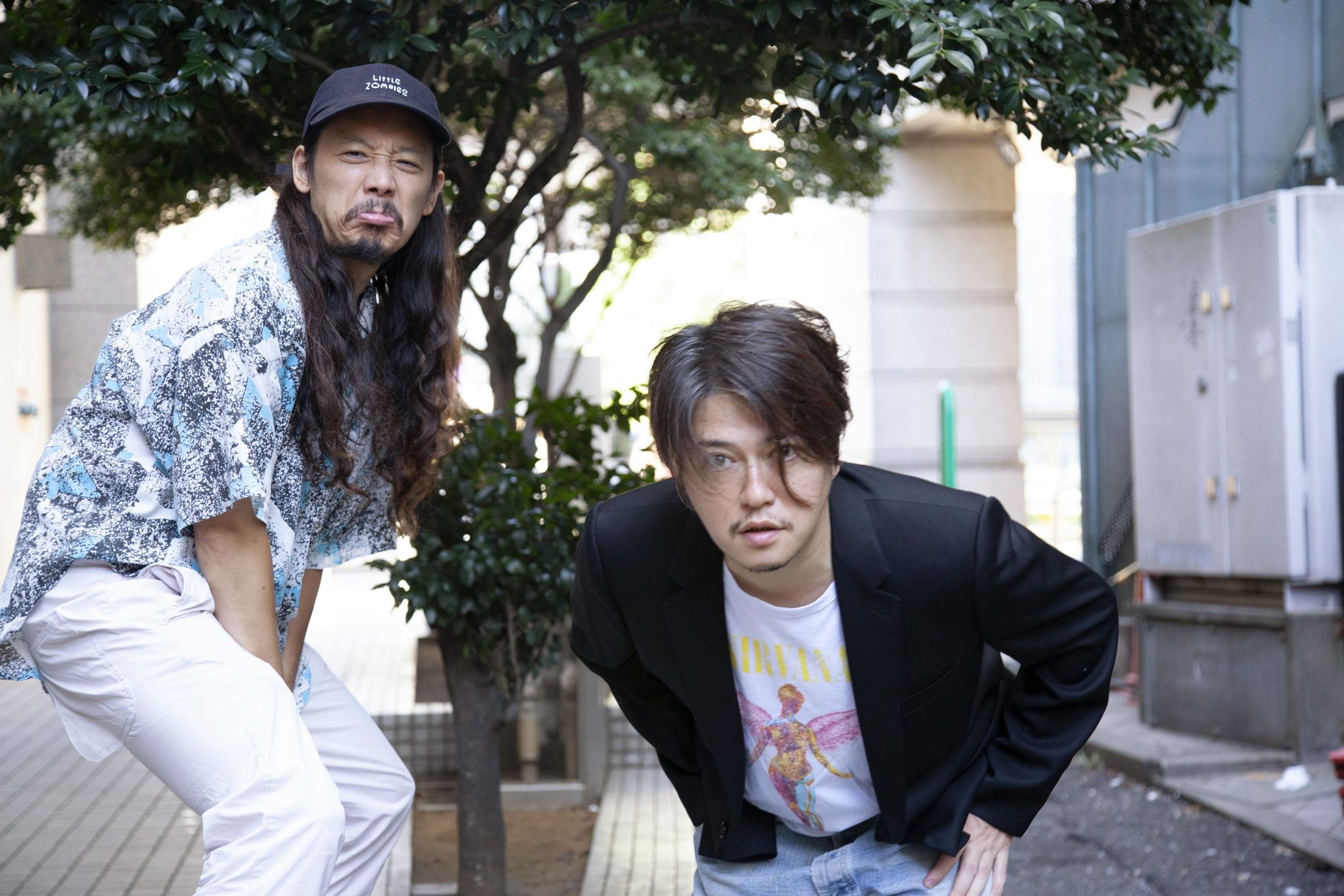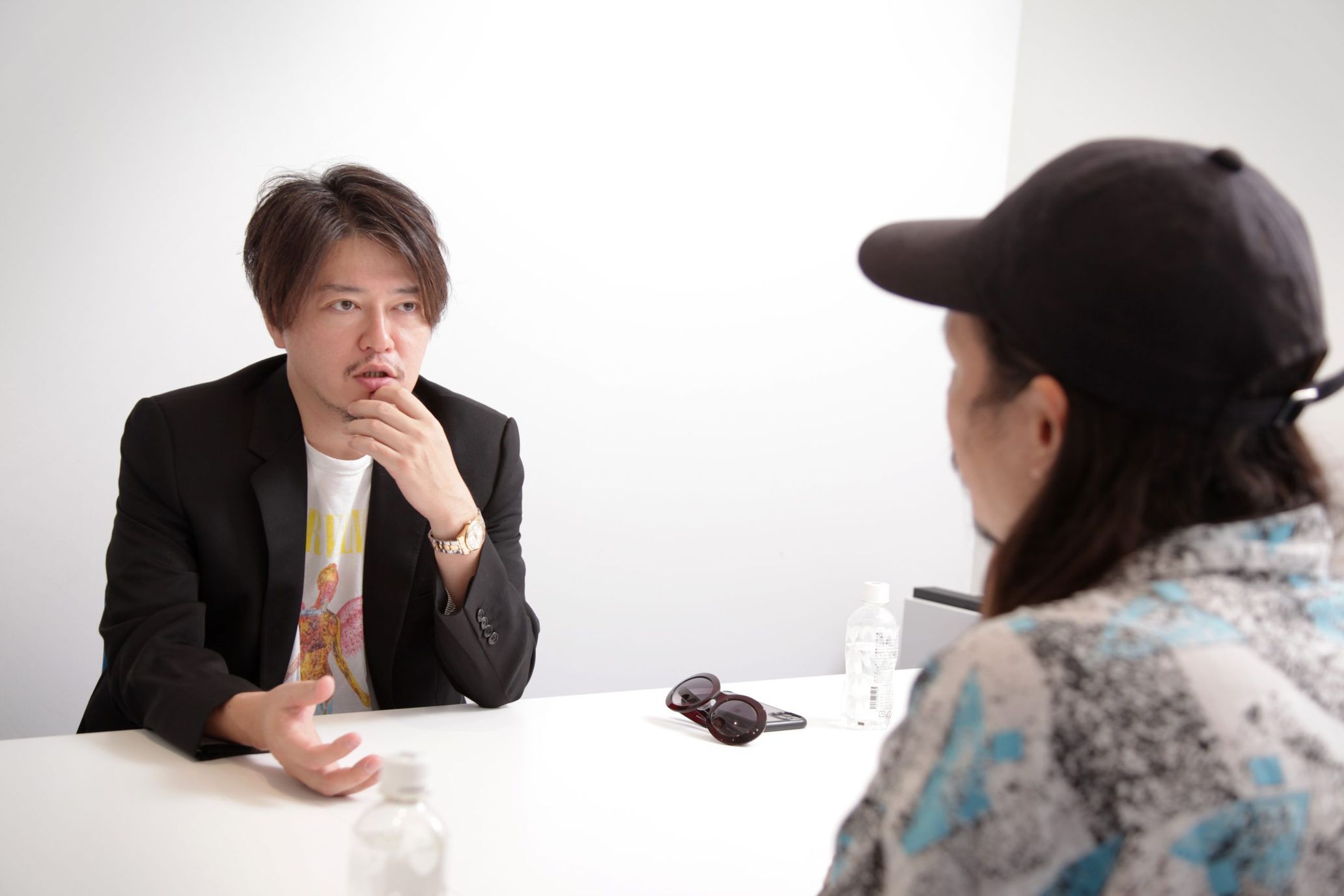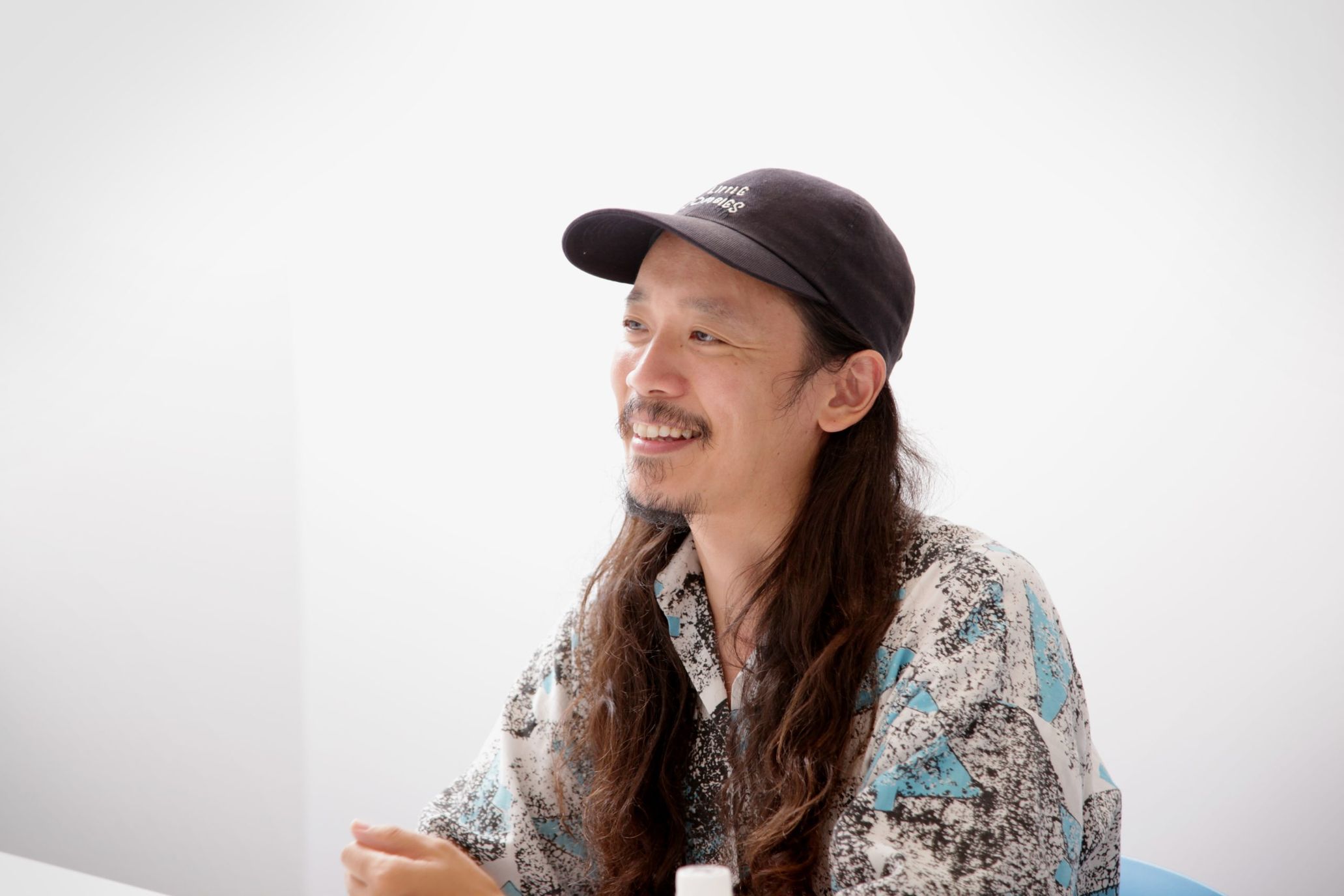Keiichiro Shibuya is a gifted musician who has continued to create fresh sounds by crossing different boundaries and evolving. This series, “Massive Life Flow,” explores his mindset and what he envisions for the future. In the eighth installment, we present a conversation between Keiichiro Shibuya, who made the music for Gucci’s short film, Kaguya by Gucci starring Hikari Mitsushima, Aoi Yamada, and Eita Nagayama, and director Makoto Nagahisa, who directed the short film.
Kaguya by Gucci celebrates 75 years of Gucci using bamboo handles for its bags. The six-minute short film is a reinterpretation of the oldest folktale from Japan, The Tale of the Bamboo Cutter (Taketori Monogatari), set in present-day Tokyo. With its reimagined setting and story, surreally beautiful and eye-catching visuals made with a distinct perspective, and the structural yet emotional soundtrack sung by android Alter4, Kaguya by Gucci became a viral sensation across the globe as soon as it was released in August. What kind of imagination and conceptualization did it take to craft this stunning story and soundtrack? Keiichiro Shibuya and Makoto Nagahisa converse about the process behind creating the short film and what we can discover from androids.

Keiichiro Shibuya is a musician who was born in 1973 in Tokyo. He graduated from the Tokyo University of the Arts with a B.A. in Music Composition and founded the music label ATAK in 2002. Notable works include a Vocaloid opera comprised of no people called The End (2012) and the android opera Scary Beauty (2018). In September 2020, he created the soundtrack for the film Midnight Swan and won the Music Award at both the Mainichi Film Awards and the Japan Movie Critics Award. In August 2021, Shibuya’s opera Super Angels had its world premiere at New National Theater Tokyo. In March 2022, he showed his new android opera, MIRROR, a collaboration between an android, Buddhist music, shomyo, and an orchestra from the UAE, at Expo 2020 Dubai. In April, he created the soundtrack for xxxHOLiC, a film by Mika Ninagawa. Further, he established the Android and Music Science Laboratory (AMSL), a science laboratory of androids and music, at the Osaka University of Arts. He explores the boundary between humans and technology and life and death.
ATAK: http://atak.jp
Twitter: @keiichiroshibuy
Instagram: @keiichiroshibuy
Left: Makoto Nagahisa
Makoto Nagahisa was born in 1984 in Tokyo. He won the Short Film Grand Jury Prize at the Sundance Film Festival for his first short film,
And So We Put Goldfish in the Pool., making him the first Japanese person to win a grand jury prize at Sundance. We are Little Zombies, his first feature-length film, was selected for the Special Mention at Berlin International Film Festival in 2019 and was included in over 37 film festivals. Nagahisa released Death Days, a 2021 short film starring Go Morita. He works in other mediums, such as theater and TV: The Rite of Love and Death (2021) and FM999 (2020).
Titter: @nagahisa
Instagram: @nagahisa
Thinking structurally and loving complexity
–How did you two become involved in making Kaguya by Gucci?
Makoto Nagahisa: Toshihiko Tanabe-san, who produced Kaguya by Gucci, reached out to Shibuya-san and me, respectively, which is how we got together. Before this project, I didn’t know Shibuya-san personally, but I had been listening to his music. I was also inspired by his opera, Heavy Requiem featuring Hatsune Miku and an android (editor’s note: a collaborative performance with Shingon Buddhist monk Eizen Fujiwara performed at Ars Electronica in 2019). So, I was elated to have been able to work with him.
Keiichiro Shibuya: I was also happy to have been able to work with you. Nagahisa-san, you used to play music, right? When you gave me your opinions and instructions on the music for Kaguya by Gucci, you used words and expressions only someone knowledgeable about music would know. So, I looked you up online afterward out of curiosity (laughs). And I found information about your musical background, just as I thought.
Nagahisa: Yes. I played jazz throughout my school years. I played the baritone for six years and the tenor sax for three.
Shibuya: Out of the various kinds of jazz, which do you like?
Nagahisa: I listen to a lot of kinds. But if I were asked who my favorite musician was, it would be Gil Evans. He incorporated something different into jazz and expanded the genre through big bands. For instance, he would play Jimi Hendrix’s music by introducing an electronic guitar into the ensemble. I find that very appealing. I used to cover his music at university.
–Your 2019 film, We Are Little Zombies, featuresNaruyoshi Kikuchi-san. Was the casting your choice?
Nagahisa: Yes. I love him as a musician and have also covered DC/PRG’s music. Kikuchi-san’s logical way of talking is also appealing to me. I reached out to him because I wanted him to be in my film, and thankfully, he said yes.
Back to my musical background: I gave up trying to become a professional sax player when I was around 20. I thought long and hard about what medium I could pour the same passion into and pivoted to filmmaking. But I’ve always loved music.
Shibuya: I see. It was easy to work with you, and much of what you did made sense to me. I gel well with directors who like complex music, like yourself (laughs). People like you see one piece of work as a structure, whether that’s music or film. I’m the same, so it’s easy to have a mutual understanding. It’s difficult working with people who only like songs, as opposed to instrumentals, or three-piece rock bands, because they focus too much on the narrative and literary aspect of music and have a low awareness of the structure (lets out a bitter laugh).
Nagahisa: I guess you can say I’m pro-intricacy. I’m the type that thinks the more intricate the relationship between things or elements, the better. I love complex things or things that many people feel are a chore.
How the modern-day version of The Tale of the Bamboo Cutter was born
–How was the concept behind Kaguya by Gucci born and nurtured?
Nagahisa: The start of the project was when the producer, Tanabe-san, told me, “I want you to create a modern-day Bamboo Cutter set in Tokyo with Princess Kaguya, Okina, and Mikado.” As a storyteller of today, I wondered how I should handle and illustrate the oldest Japanese tale because it was created over a century ago. I had to clarify my perspective on The Tale of the Bamboo Cutter. I let my thoughts marinate, and the conclusion I came to was to go against the original story.
“Even if a story’s synopsis and ending are set in stone, each character has the right to insert their ideas and views into the story.” By rewriting a story based on this line of thinking, I wanted to express meanings and values that could exist precisely because of our current times. In Kaguya by Gucci, Okina resists saying goodbye to Princess Kaguya, and Mikado doesn’t stop loving Princess Kaguya even if he knows they won’t end up together. The lyrics sung by Alter4 in Shibuya-san’s soundtrack are written from that perspective. The lyrics say something like, “I don’t exist to play a role imposed on me.”
–Alter4 appears in the short film with you, Shibuya-san, and its makeup packs a punch.
Shibuya: Alter4 made its debut with this short film and played an important supporting role. When I explain that to people from other countries, they say, “Now that you’ve mentioned it, it makes sense.”
Nagahisa: True. It might be easier for people from other countries to understand the story once you provide historical context, like noh, into account.
Shibuya: Some cultured people from other countries are more well-versed in traditional Japanese culture than Japanese people.
The AI learned Nagahisa-san’s text to generate a portion of the lyrics, so his name is credited alongside Cypher, the AI. The AI named itself.
Most AI names are boring, as they come from ancient gods or classic figures (laughs). I didn’t want the AI to have a name like that, so I was like, “What should I do?” I asked the AI, “What should we call an emerging lyricist who people would want to follow?” And it answered, “Cypher.” It signifies zeroes and passcodes, which I thought was excellent. That became the official name.
A structural approach to making the soundtrack

–What was your approach to making “I come from the Moon,” the track you wrote for this short film?
Shibuya: As I mentioned before, I view music and film in a structural way. I believe people feel moved by structure.
The most important thing about this song was for it to be circular-shaped. In the film, many circular shapes are shown abstractly, like close-up shots of the characters and Alter4’s eyes, and the moon. The cyclical nature of the film is shown at the end when Aoi (Yamada)-san, playing the role of Okina, says the same line as the beginning, “This is a fairy tale.” Both abstractly and structurally, the circle was important. It’s the shape of the moon, of course. I thought about how I could portray that with the music.
Another central element is the scene where Okina, played by Aoi-san, runs up Tokyo Tower to reach Princess Kaguya, played by (Hikari) Mitsushima-san. The shape of the circle in psychoanalysis can be interpreted as a symbol of female genitalia. Meanwhile, a phallic shape, Tokyo Tower, makes an appearance. It depicts a love story between two women, but a sign of maleness exists there too. I felt like that would play on the viewer’s subconscious in a powerful manner. I felt like the scene needed a melody with a strong drive.
–I see. I can tell that you analyzed the story structurally and symbolically to create the soundtrack.
Shibuya: But if the melody surged at that Tokyo Tower scene, that would’ve equated to reaching an orgasm, so I couldn’t do that (laughs). As Nagahisa-san said, the vital theme was to go against something, so I played a descending melody in contrast to the ascending chords.
The BPM rapidly increases once she starts running up Tokyo Tower, but when Princess Kaguya and Okina embrace each other at the climax of the scene with the moon in the background, the BPM rapidly decreases and returns to the same BPM as the first scene. That’s how I portrayed the circular structure of the short film through music.
Nagahisa: The music is terrific in every scene. I love the part where Princess Kaguya and Okina turn into small figurines and dance together. In that scene, live action turns into CGI, and the tone of the music changes drastically too. It matches the visuals.

–Speaking of tone, you used the sound of live drums and electric bass instead of synth bass, which you seldom use in your music.
Shibuya: Because the android plays the key part of a storyteller and singer, I felt combining the singing voice with a human touch would sound more interesting. This project allowed me to consider the distance between machinic and human things. Aside from the bass, I used a simulation of electric guitar and live drums from the 50s. Whenever an android is the central part of a song, it makes me want to produce this kind of tone for some reason.
–As you mentioned, Nagahisa-san, there’s a strong cohesion between the visuals and music. You must’ve paid acute attention to that.
Nagahisa: Yes. It’s about the small details: you’d get a vastly different impression if a song—with its swelling and reverberations—ends with a cut instead of lingering until the next. We matched each frame with the sound until the last minute.
Shibuya: I’m sure Nagahisa-san’s experience in shooting commercials plays a big part in how he’s more meticulous about and aware of cuts and frames than directors who only create their own work. Even regarding the sound, he said, “People won’t feel moved if the attack doesn’t come in at the tenth frame!” I believe that sort of meticulousness is absolutely right. It’s ineffective if you can’t convey something that’s numerical by nature by using numbers. It’s out of the question.
What can we gain from androids?

–What was it like working with an android, Nagahisa-san?
Nagahisa: I make films based on the disconnection or discrepancy between life and death and emotion and expression, and I think that won’t change in the future. Androids are important to me because they’re relevant to my interests. Androids are bound to become more widespread and necessary in the future, so it was a memorable experience to sit down with an android that tells stories.
Shibuya: Androids are interesting, even from the perspective of filmmaking and acting. In the past, the benchmark of a good actor or film was how well emotion and motion could be connected and expressed. (Jean-Luc) Godard “cut” into that with his own method and created a new form of film. With androids, nothing connects the android to the human being, to begin with. The very existence of androids begs the question, “What is emotion?”
Nagahisa: I agree. I’ve always felt that emotion and motion aren’t aligned. We usually respond to situations out of reflex instead of emotion. I feel like that disconnect or inconsistency is so beautiful. That’s why I’m drawn to androids, as they embody that.
Shibuya: People act out of reflex and habit, and there’s always a social component behind what they like. The existence of idols not only hinges on appearance but on the social values that deem them “kawaii.” It’s not rare to meet an idol that’s actually not that kawaii (laughs). It seems like more people are beginning to see that people don’t act out of emotion as much as we had thought.
–It also seems like our awareness and sensibility regarding human existence and emotion are changing because of AI and androids.
Shibuya: Once the prerequisite of emotion disappears, the way we create stories will change. It’s a major opportunity for Japan. Fundamentally, Europe is anthropocentric, and they don’t doubt the existence of humans. It could be hard to eliminate the belief that humans have emotions and robots don’t. But I feel like we in Japan can create a new story based on a different set of values.
Nagahisa: People in Japan have created joruri for generations, so we have a strong foundation.
Shibuya: Exactly.
Nagahisa: There’s the belief that puppets have emotions and that humans don’t have emotions that puppets can’t express. I feel like that’s something people from other countries don’t feel.
Shibuya: I call that the “new ethnic.”
Nagahisa: I understand. My films are more popular in America and Europe than in Japan, but not because of the direct depictions or motifs. They see a distinct, ethnic Japanese quality in, say, my dry, blunt approach to giving up or how sadness doesn’t come to the fore. They think it’s interesting.
Shibuya: Over the past ten years, I’ve portrayed the existence of the self in an obscure way and made the emotions impossible to ascertain in my work. I assume people from other countries are more prone to discuss such themes than Japanese people.
Nagahisa: I see. When we made Kaguya by Gucci, Tanabe-san told me you and I have similar views on society and human beings. I saw what he meant today while we covered various things. Thank you.
Shibuya: Thank you. It was fun talking to you.
Photography Tasuku Amada
Translation Lena Grace Suda
